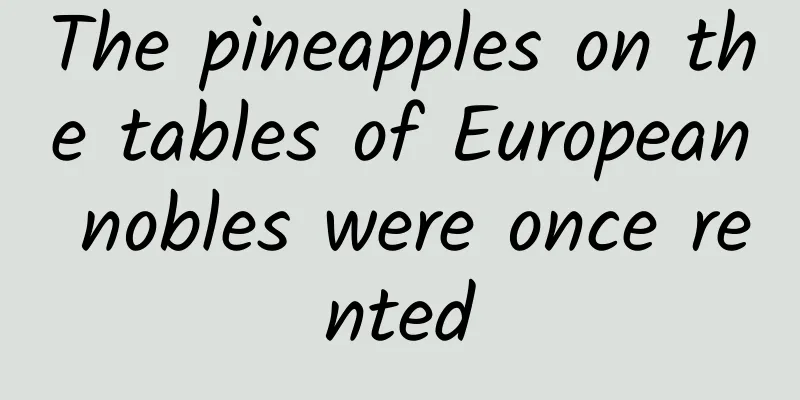The pineapples on the tables of European nobles were once rented

|
For someone who likes pineapples, even if the pineapple season is over, it shouldn't be difficult to put a pineapple on the table. Just buy it. What's more, this is a European aristocratic family. Pineapple is a common fruit in the market | sonya / Wikimedia Commons However, things are not as simple as imagined. The hostess has been preparing for this important dinner party for a long time. However, there is still an important protagonist missing from the table, which is also the protagonist of our species calendar today, the pineapple. A carrot is hard to find | Wikimedia Commons Rent a pineapple For a European aristocratic family in the 17th and 18th centuries, how to leave a deep impression on fellow aristocrats at dinner parties and social gatherings was a problem that every European aristocrat had to face. When Columbus brought back pineapples from the New World, the answer became simple. As long as, even just one pineapple appeared in the center of the table, it not only meant the host's hospitality, but also wealth, value, prestige and dignity. Pineapple painting | Wikimedia Commons Throughout 17th century Europe, the pineapple was a symbol of luxury, nobility and wealth. The pineapple would be placed high on a pedestal in the center of the dinner table, on top of the central pile of food, like a king, looking down on all living things. However, pineapples are really valuable. Someone once estimated that if the current value is used, the price of a pineapple is about 50,000 to 100,000 US dollars. Even for the nobility, pineapples are no longer a kind of food, but a work of art with great spiritual temperament. Pineapple in bloom | Marco Schmidt / Wikimedia Commons So, if this European aristocratic family was not like Sir Matthew Dekker in Surrey, England, who was not only rich but also had his own professional gardener and a new greenhouse designed specifically for growing pineapples; nor was it a monarch of a major European country like Louis XV, Catherine the Great or Charles II, who could spend a fortune on a pineapple; the price of a pineapple would probably have been prohibitive for her. Fortunately for the socializing European aristocracy, a pineapple rental store emerged during this era to serve the aristocracy's gatherings. To solve the hostess's worries, rent a pineapple. Rented pineapples can only be looked at but not eaten | Tuchong Creative Therefore, for those who have achieved the freedom to eat pineapples today, it is difficult to understand that at an aristocratic dinner in the Scottish Highlands in the 18th century, the pineapple that was the center of people's vision was - Just rented. New Eden's Gift The English word for pineapple is Pineapple, which is composed of pine tree (Pine) and apple (Apple). Today, it is generally believed that Christopher Columbus was the first European to taste the flavor of pineapple. Columbus: Yes, it's me again | Wikimedia Commons In November 1493, Columbus' second voyage arrived at Guadalupe, a volcanic island with lush vegetation in the Caribbean Islands. The Indians on Guadalupe treated Columbus and his sailors with pineapples. This tropical fruit has a rough appearance and looks like a pine cone, and tastes as fragrant, crisp and sweet as an apple. Columbus called it "the Indian pine" (piña de Indes) and declared that pineapple is "the most delicious fruit in the world." The Indians living on the island used pineapples as food and also used them to make pineapple wine. Pineapple seafood rice | Tuchong Creative On his return trip, Columbus took many pineapples with him as gifts to Queen Isabella and King Federand II, who had financed his voyage. However, pineapples are not durable in storage, and all the pineapples bound for Europe rotted during the voyage. According to legend, only one pineapple survived. This lucky fruit, full of exotic flavor and wonderful fragrance, deeply conquered and impressed the Spanish royal family. Pineapple became the exclusive enjoyment of the Spanish royal family, and they regarded it as a fruit from heaven. With the advent of the Age of Exploration, every pineapple that traveled across the ocean became the darling of the times that conquered the top aristocratic circles in Europe, and was given titles such as "the king's table fruit" and "the prince of fruits". Pineapple stands out among many fruits | Tuchong Creative In 1640, John Parkinson, the gardener of King Charles I of England and the title of "Chief Botanist to the King", wrote in his book "Theatre of Plants": "Its taste is so wonderful that it tastes like wine, rose water and sugar mixed together." Pineapple presented to the King of England | Wikimedia Commons Fine Fruit The pineapple has 30 to 40 hard, juicy leaves, tightly arranged in a rosette on a thick fleshy stem. During the flowering period, the pineapple will extract the inflorescence from the leaves of the rosette, and around the increasingly swollen pine cone-like inflorescence axis, hundreds of light purple flowers are arranged in a spiral in the fleshy light reddish-green bracts. The pineapple's small flowers are rich in nectar, which will attract hummingbirds to come and feed, and sometimes bats come to enjoy the delicious food. Pineapple plant | Louise Wolff / Wikimedia Commons A pineapple is not "a fruit", but a multiple fruit formed by the fusion of many small flowers wrapped in fleshy bracts around the inflorescence axis. The "fruit" of the pineapple that people eat is actually mainly the fleshy, swollen inflorescence axis and the small flowers arranged spirally on the periphery. For a better taste, the small flowers of cultivated pineapple varieties rarely bear fruit. Columbus enjoyed pineapples served by the hospitable Indians on Guadalupe Island, but this delicious fruit is not native to this volcanic island. Pineapples come from the more distant American continent, where the Mayans and Aztecs have long cultivated this crop. In the Paraguay River Basin in Brazil, Paraguay and Argentina, the Tupi-Guarani people living in this area call pineapples nanas. Pineapple plantation in the Philippines | Obsidian Soul / Wikimedia Commons In the local Indian language, nanas means "superior fruit". This is the real hometown of pineapples. Before the colonists "discovered" the "New World", American Indians had cultivated pineapples for thousands of years, and the pineapple varieties they cultivated have become extremely sweet and delicious. In addition to being used as food, American Indians also use pineapples as medicine, using the pineapple bark fiber to make bowstrings and threads for sewing fabrics, and also use pineapples to brew fine wine. Pineapples are called "nanas" in the local language | Serenity / Wikimedia Commons Pineapple greenhouse Long before pineapples evolved from a luxury item on the tables of the nobility to a delicacy that ordinary people could enjoy, along with the desire, bloodshed and monopoly of the Age of Discovery, colonists developed countless pineapple plantations in colonies around the world. In 1661, when Zheng Chenggong recovered Taiwan, the Dutch colonists who had seized the island had already been planting pineapples on the island for many years. At about the same time, pineapples introduced from Macau, the Philippines and other places also began to be planted in southern China. Pineapple Pizza | Famartin / Wikimedia Commons In order to have pineapples on the tables of the British king, nobles and emerging dignitaries at any time, British horticulturists began to try to grow pineapples in gardens in the 18th century. Pineapples are afraid of both cold and heat, and cannot tolerate frost or temperatures above 40 degrees Celsius. Their fragile roots also require a well-drained and ventilated environment. Countless gardeners have begun the challenge but have found it extremely difficult to succeed. Pineapple greenhouse | Ajay Suresh / Wikimedia Commons It was not until 1720 that Henry Telende, a Dutch botanist and personal gardener of Sir Matthew Decker in Surrey, designed a complete and extremely complex pineapple greenhouse system, which finally realized the dream of growing pineapples in the garden and made it possible to grow pineapples on British soil. Although it was a huge investment and the pineapples obtained from such a greenhouse were very valuable, Henry Telende's creation greatly promoted the development of modern greenhouses. It was also because of the greenhouse that some popular pineapple varieties and countless new crop varieties were continuously cultivated and created by gardeners, and some varieties have even been cultivated to this day. |
<<: Why can’t a girl unscrew the cap of a bottle but can unscrew the top of her boyfriend’s head?
Recommend
Remember! Do not perform time-consuming operations in the UI main thread
question Since the release of Android Ice Cream S...
What should I do if the effect of Baidu search promotion is getting worse and worse?
Many people may have this idea, that is, they fee...
A famous singer has passed away! This type of cancer is usually discovered in the late stages, and it is dangerous if the waist circumference exceeds this number...
Cheng Zhi, a famous tenor singer and first-class ...
Is the “hydrogen balloon” filled with hydrogen or helium?
When I think back to my childhood, I can’t help b...
Small brands want to break through, but what they lack is not methods, but problems...
Someone left me a message before, asking if I cou...
Tik Tok funny video editing tutorial, easily edit popular videos in two hours a day
Tik Tok funny video editing tutorial, easily edit...
The most powerful method to obtain seed users for App promotion!
No matter how cool the concept of a product is or...
The best marketing channel selection strategy for advertising!
"If I give you 10 million, how would you spe...
How to solve the problem of users’ independent dissemination and sharing in APP operation?
Are you a good APP operator ? How many users does...
Real-life version of "Fragrant Concubine"? Newborns have a sweet fragrance all over their bodies that can't be washed off! It turns out to be a disease...
Expert of this article: Zhu Hongjian, Director of...
How much does it cost to attract investment in Lanzhou Entertainment Mini Program? What is the investment price for Lanzhou Entertainment Mini Program?
Starting a business requires costs, and mini prog...
Medical AI technology is hot, but where does its business model end?
These are exciting times. With the huge wave of i...
What is online promotion? Do you know several promotion channels?
The Internet is an information gathering field, t...
Can regular infusion prevent cerebral infarction? Don't believe it, it's very dangerous!
Rumor: "Regular infusion can prevent cerebra...
Helen SEO Training: A brief discussion on the secrets of getting the top 20 to 30 websites on Baidu to the homepage
It is not easy for a website to build its homepag...









